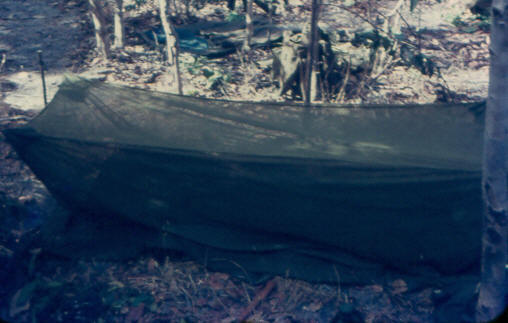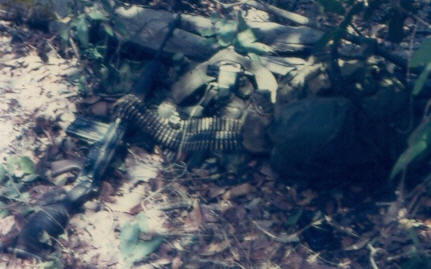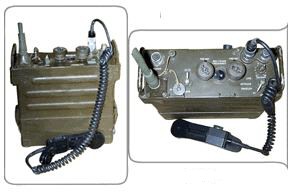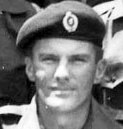![Lcpl Bruce Young - Nui Dat 1970 [Young]](images/young_head.jpg) Equipment
and Weapons - Bruce Young
anyone can add to or correct this article Equipment
and Weapons - Bruce Young
anyone can add to or correct this articleThis is a background article on the
variety of weapons and equipment carried by W3 Coy people in the field. Within this basic framework individuals customised
their equipment for a variety of reason - comfort, task, appearance, requirement.
Servicemen generally wore Australian designed uniforms called 'jungle greens' [JG's or 'greens'] although New Zealand designed equipment was sometimes seen [but not replaced when worn out]. US uniform items were also worn in the field [never in base] but were not supported by the [mainly Australian] logistic system. When the W3 CQMS 'scored' a truckload of US uniforms, items from this were used unofficially. The floppy green bush hat was standard and while almost everyone had a sweat rag few wore them around the forehead as the floppy hat was used as a means of recognising our people during a contact. Footwear was usually Australian GP high boots. lightweight shelter in bamboo [Philip] Field equipment was mainly Australian designed light-weight green bedding [air bed that also served as a hammock or stretcher - the air tubes were mostly discarded on patrol as being noisy, heavy and unreliable], and a light-weight green tent shelter large enough to cover the individual and his equipment. The tents however shone when wet and made hearing difficult when it was raining. An Australian camouflage raincoat was so poorly designed as to be a joke, and Kiwis [and most Aussies] usually preferred to just be wet. While ex-UK/Malaysia and US field equipment was available it was usually too bulky for comfort on patrol and was restricted to base areas. An Australian light-weight field mosquito net was standard issue for sleeping , as were anti-malarial drugs and mosquito repellent. Spare 'greens' were usually carried.
Australian model mossie net erected without the shelter tent. It was the practise to erect net and shelter together with slip knots that allowed them to be quickly erected and collapsed in the dark. Equipment, clothing, rations
and other stores [radio batteries, canteen orders would be examples] were normally flown into the field on a three day cycle. Individuals
could request replacement of damaged personal items and the platoon sergeant would consolidate the requirements into a
MAINTDEM and pass it by radio using commodity codes to Coy HQ/CSM. The CQMS in Nui Dat would
assemble the items and arrange transport into the field [resup]. After a contact the platoon sergeant might compile a list
of urgent operational items [ammunition and other stores] into an OPDEM which would be passed on
the command net and delivered ASAP to the field. Pte Don Wolff using US Special Forces pack - frame visible below ammo belts [Goodman] Load carrying equipment was varied - few carried the Australian unframed
field pack as it was uncomfortable
and had limited capacity.
ARVN pack This [degraded] list from 1970
details the field equipment issued to W3 Coy people. L1A1 SLR 7.62mm semi-automatic rifle There was little specialist equipment, no night vision 'Starlight Scopes'
or other aids [GPS hadn't even been invented..!], if specialist support was required the
specialists provided their own equipment. An example might be mine clearing; if mines were suspected an engineer mine
clearing squad would be attached and bring mine detector equipment. Some explosives might be carried, detonating cord
might be carried to quickly blo Rations were generally a mixture of Australian and US 'C' [combat] rations. The US Supplementary Pack [US cigarettes, chocolate and toilet items] was issued at the scale of 1x 100 people/day and shared where the need was. Australian rations were either freeze-dried [OK in the wet season] or tinned, the tins were mainly meat and tasteless. US C rations were also mainly meat and over spiced - there was a theory advanced that limiting vegetables reduced the need for bowel motions and therefore the need for field latrines..! The fresh hamburger bun loaded with salad and meat with fresh carton of milk provided each soldier after a resup was usually sufficient to move the bowels..! To overcome the tasteless rations some individuals would find a flavoursome sauce and add this to every meal. Water was either delivered in 40 litre plastic cans or taken locally and chemically altered to make it safe to drink. Rubbish was never discarded but carried on the man and back loaded to Nui Dat during resup. note 'shell' dressing on rifle butt and belted ammunition carried as spare for the section machine gun Every section carried a variety of different coloured smoke grenades [for LP marking normally], trip flares, HE grenades [with taped levers and carried internally for safety], claymore AP mines, empty sandbags, and small entrenching shovels. It was not normal to carry WP [white phosphorous] grenades as these were considered personally highly dangerous if struck during a contact. Navigation was maintained by the use of US or Australian topographical and photo maps, a protractor, compass [the UK model steel prismatic compass was preferred to the US model plastic combined compass/protractor as plastic was quickly corroded by mosquito repellent], and a pace counter [taped to a weapon and 'clicked' every second pace - about a metre]. While US model field watches [called 'Mickey Mouse watches' by the troops] were available, being plastic they too quickly became unreadable. [more details here] Medical support other than for wound trauma would be initially provided by trained riflemen or a specialist medic, using stores carried in a small medical rucksack, but any major problems were evacuated to provide both prompt treatment and to allow the remainder to patrol unhindered. [see this article for more detail] What weight did individuals carry..? This link
has detail of a weight-in Coy HQ did before deploying by air, it appears a typical soldier [see this photo] was likely to be carrying up to 90 Kg [about 200
Radio nets available to the Coy HQ were: AN/PRC-25 field VHF radio set The fighting structure of W3 [and the Australian battalions and other NZ companies] was drawn from the standard light UK battalion organisation with minor adjustments to suit conditions. A rifle section of up to 10 people [but usually 6-8 due to leave, illness etc] with a platoon HQ [usually 4-5 people] would patrol as follows [there were three rifle sections in a platoon]: Lead Scouts: [two people - tended to have less
load than others to assist alertness] Section Commander: [a corporal -
tended to have some specialist equipment] US M16A1 5.56mm semi and fully automatic rifle [AWM] Section Machine Gunners: [two people -
tended to carry too much ammunition] US M60 7.62mm general purpose machine gun GPMG [internet] Section Rifleman: [five or less people including
the section 2IC - tended to be 'packhorses']
M79 shoulder fired 40mm grenade launcher [internet] Platoon Commander: [a lieutenant -
tended to have some specialist equipment] Platoon Signallers: [two people -
always close to either the platoon commander or sergeant] Mortar Fire Controller: [attached from
mortar section - always close to the platoon
commander] Platoon Sergeant: [a sergeant -
controlled the rear, and platoon administration including resupply] single-shot disposable M72 LAW shown extended ready to fire [internet] in case it is thought that the amount of ammunition carried was exaggerated here is the actual order detailing ammunition scales within W3 Coy this link has photos of US equipment from the Vietnam era this link has a more comprehensive list with photos of Australian and New Zealand equipment
'I was There' - Bruce
Young
|
| Commemorating
David Wright – Bob Upton
"First, on behalf of those members of W3 Company present today can I sincerely thank those responsible for organising today's unveiling and for inviting us to be part of it. More importantly we present and other company members, are touched to see that the supreme sacrifice made so long ago by one of our company David Wright is now acknowledged alongside other old boys of Christ College who also died on active service. Most here today will know
nothing about W3 Company or David Wright so let me give y Before deploying to South Vietnam in November 1969, for our 12 month tour of duty, W3 Company spent a considerable period of time training in Malaysia. It was in Malaysia, when I became his platoon commander, that I first remember meeting David Wright. He was physically a very big man, with blonde hair and a young face. I quickly learnt David was an outstanding fast bowler and in those days I was a bit of a wicket keeper. Thanks mainly to the exploits of David our company team won the British Commonwealth military cricket competition in 1969. In the final, we played a British Military Hospital team who had some very talented players including a batsman who had played for the MCC. David as I recall took 7 wickets, 5 being caught by the keeper. This just shows that while there may be strong rivalry between pupils and old boys from Christ College and Boys High School, when necessary against a common foe we can unite into a formidable combination. David Wright RNZIR - old Boy Christ's College Christchurch [archives] David Wright had a generally quiet unassuming nature, a dry sense of humour and a close circle of good friends. Like most young soldiers of the time David lived life to its fullest. He never hesitated to test the boundaries and if he thought he may have been caught or was in trouble he tended to adopt the ‘ very innocent not me Boss’ attitude. Within the platoon David was the cover scout in his section. This was an important role because he had to protect the lead scout who, particularly in heavy jungle, was often very vulnerable as he forced a track through the vegetation. It required good infantry skills, patience and concentration. David never once failed his lead scout. On 30 January 1970, in a contact with a group of enemy, David was very badly wounded. Although in a lot of pain he showed more concern for his good mate George McLeod, who was also wounded in the incident, than for his own wellbeing. David and George were extracted from the bush by a DUSTOFF helicopter. After they had been stabilised in a hospital in Vietnam they were flown back to Australia for further treatment. Sadly, some 6 weeks later, on 19 March, David succumbed to a secondary infection and died. Fellow platoon members remember hearing of his demise with utter disbelief as only a couple of days earlier some had received letters written by David in Sydney which indicated his sense of humour had returned and he was well on the road to recovery. David is buried along side his Dad in the cemetery adjacent to the lovely little church in Esk Valley just down the road and inland from St Andrews in South Canterbury. At a welcome home parade for Vietnam veterans in Sydney in 1987, 37 New Zealand flags, each one representing a Kiwi serviceman killed in the Vietnam conflict, were carried. Subsequently, each next of kin was presented with one of these flags. In 1989, at a service attended by David’s mother his flag was hung in the Esk Valley Church. Where today he lies in peace he has a magnificent view: to the east the vast expanse of the Pacific Ocean and westerly the towering Southern Alps. I would confidently predict
that 40 years ago when a young David Wright sat, like you do today, in this chapel, he would never have envisaged that within
5 plus years he would have volunteered to join the Army and do his duty by serving his country at war in
Vietnam. All of us present today, pray that
none of you young men will ever have to do your duty and serve your country in a conflict. However, I would contend
that, in this troubled world we live in today, it is naive for you to believe that it will never happen. If it did
happen how would you react? Understandably while most would not be entirely happy about it, hopefully all of you would undertake your duty in the
same professional and dedicated manner those
previous generations of Old Boys of this College have. Finally I leave you with this to contemplate and reflect on: It is the soldier not the reporter, David N Wright, whose memorial we unveil today, was one of those soldiers. |
![lightweight shelter in bamboo [Philip]](images/relax_shelter.jpg)

![Don Wolff using US Special Forces pack - frame visible below ammo belts [Goodman]](images/DWolff.jpg) [
[ The US
Special Forces framed pack was popular especially with signallers but otherwise offered
too much capacity [and temptation to overload]. The ARVN framed field pack was a good compromise
and popular [when it could
be procured - often on R&C breaks in Vung Tau]. Webbing was a mixture of US belt
and suspenders and water bottles but where available the UK pattern large pouch was preferred to the smaller US field pouch.
Individuals carried a large trauma 'shell' dressing, strapped in most cases to the rifle butt,
and applied by a 'buddy' if
wounded.
The US
Special Forces framed pack was popular especially with signallers but otherwise offered
too much capacity [and temptation to overload]. The ARVN framed field pack was a good compromise
and popular [when it could
be procured - often on R&C breaks in Vung Tau]. Webbing was a mixture of US belt
and suspenders and water bottles but where available the UK pattern large pouch was preferred to the smaller US field pouch.
Individuals carried a large trauma 'shell' dressing, strapped in most cases to the rifle butt,
and applied by a 'buddy' if
wounded. ling]. Rifle slings were carried [in a pouch] but never placed on the weapon when in the bush.
ling]. Rifle slings were carried [in a pouch] but never placed on the weapon when in the bush. w trees over to create emergency helicopter
w trees over to create emergency helicopter  Lbs] of
stores in his belt and pack.
Lbs] of
stores in his belt and pack.![US M16A1 5.56mm semi and fully automatic rifle [AWM]](images/M16A1.jpg) r safety.
r safety. ![US M60 7.62mm general purpose machine gun GPMG [internet]](images/M60_gpmg.jpg)
![M79 shoulder fired 40mm grenade launcher [internet]](images/m79_launcher.jpg)
![single-shot disposable M72 LAW shown extended ready to fire [internet]](images/m72.jpg)
 'I was There' - Evan Torrance
'I was There' - Evan Torrance![Bob Upton 1970 [Young]](images/upton_small.jpg) The following address was given to the assembled pupils of Christ's College Christchurch by Bob Upton on 3 August
2005 on the occasion of the unveiling of a commemorative plaque in the chapel entrance to remember old boy David Wright. Bob
was David's platoon commander in Vietnam.
The following address was given to the assembled pupils of Christ's College Christchurch by Bob Upton on 3 August
2005 on the occasion of the unveiling of a commemorative plaque in the chapel entrance to remember old boy David Wright. Bob
was David's platoon commander in Vietnam.![David Wright RNZIR - old Boy Christ's College Christchurch [archives]](images/Wright1.jpg)